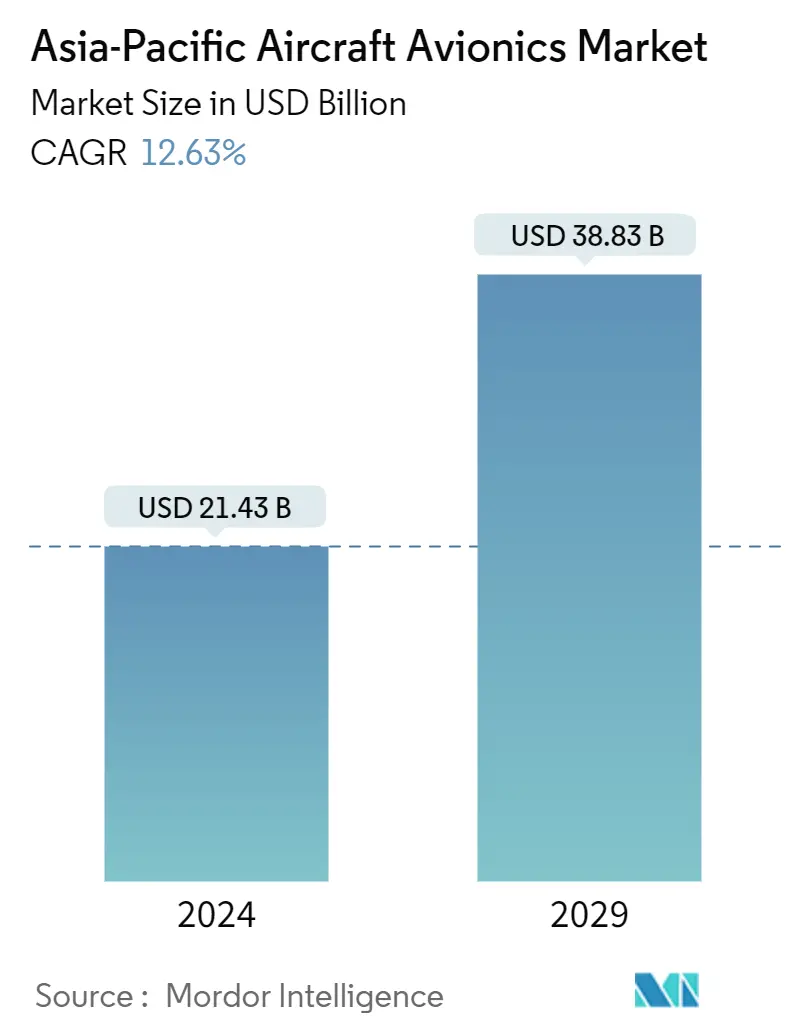Market Size of Asia-Pacific Aircraft Avionics Industry

| Study Period | 2019-2029 |
| Base Year For Estimation | 2023 |
| Market Size (2024) | USD 21.43 Billion |
| Market Size (2029) | USD 38.83 Billion |
| CAGR (2024 - 2029) | 12.63 % |
| Market Concentration | Medium |
Major Players
*Disclaimer: Major Players sorted in no particular order |
Asia-Pacific Aircraft Avionics Market Analysis
The Asia-Pacific Aircraft Avionics Market size is estimated at USD 21.43 billion in 2024, and is expected to reach USD 38.83 billion by 2029, growing at a CAGR of 12.63% during the forecast period (2024-2029).
- Asia-Pacific is the fastest-growing aviation market in the world in 2022. Countries in the region, like India, China, Indonesia, and Vietnam, are among the fastest-growing aviation markets in the world. Tourism growth has also been defining the state of the commercial aviation market in the region. Increasing air traffic, rising spending on the aviation sector, and growing procurement of commercial and military aircraft create demand for avionics systems, which in turn drive the market growth.
- According to the International Air Transport Association (IATA), in mid-2020, China surpassed the US in terms of passenger capacity and became the largest aviation market in the world. Also, the IATA projected that India will surpass the UK and become the third-largest aviation market by 2024.
- Furthermore, countries, like Indonesia, Malaysia, Vietnam, Thailand, and Singapore, among others, have been attracting massive passengers from various areas around the world, making the airlines introduce new routes and add new aircraft to their fleets. Furthermore, growing investments in the defense sector and procurement of next-generation fighter jets lead to rising demand for advanced avionics. The adoption of new navigation and communication systems for military aircraft drives the market growth. On the other hand, stringent design regulations from aviation authorities and the high cost of installation due to ongoing technological disruptions hinder market growth.
Asia-Pacific Aircraft Avionics Industry Segmentation
Avionics is an assembly of electronics subsystems integrated onboard an aircraft to carry out several mission and flight management tasks. These systems include engine controls, flight control systems, navigation, communications, flight recorders, lighting systems, fuel systems, electro-optic (EO/IR) systems, weather radar, and performance monitoring systems.
Asia-Pacific avionics market is segmented based on application and geography. By application, the market is segmented into commercial aircraft, military aircraft, and general aviation aircraft. The general aviation aircraft includes helicopters, business jets, and turboprop aircraft. The report also offers the market size and forecasts for five countries across the region.
For each segment, the market sizing and forecasts have been done based on value (USD).
| Application | |
| Commercial Aircraft | |
| Military Aircraft | |
| General Aviation Aircraft |
| Country | |
| China | |
| India | |
| Japan | |
| South Korea | |
| Australia | |
| Rest of Asia-Pacific |
Asia-Pacific Aircraft Avionics Market Size Summary
The Asia-Pacific aircraft avionics market is experiencing rapid expansion, driven by the region's status as the fastest-growing aviation market globally. Countries such as India, China, Indonesia, and Vietnam are at the forefront of this growth, fueled by increasing air traffic, rising tourism, and significant investments in both commercial and military aviation. The demand for advanced avionics systems is being propelled by the procurement of new aircraft and the introduction of next-generation fighter jets. However, the market faces challenges from stringent regulatory requirements and the high costs associated with technological advancements. The recovery of passenger traffic post-pandemic and the surge in domestic travel further bolster the demand for commercial aircraft, thereby enhancing the prospects for the avionics market.
China plays a pivotal role in the Asia-Pacific avionics market, with its robust defense spending and ambitious aircraft development programs like the COMAC C919. The country's position as a leading operator of business jets and its significant investments in military aviation, including advanced stealth bombers and helicopters, underscore the growing demand for avionics systems. The market is semi-consolidated, with major players such as Collins Aerospace, Honeywell International Inc., and THALES dominating the landscape. Innovation and strategic partnerships are crucial for sustaining competition, especially for smaller companies. Recent developments, such as the introduction of new cockpit technologies and long-term support contracts, highlight the dynamic nature of the market and the ongoing efforts to enhance avionics capabilities across the region.
Asia-Pacific Aircraft Avionics Market Size - Table of Contents
-
1. MARKET DYNAMICS
-
1.1 Market Overview
-
1.2 Market Drivers
-
1.3 Market Restraints
-
1.4 Porter's Five Forces Analysis
-
1.4.1 Threat of New Entrants
-
1.4.2 Bargaining Power of Buyers/Consumers
-
1.4.3 Bargaining Power of Suppliers
-
1.4.4 Threat of Substitute Products
-
1.4.5 Intensity of Competitive Rivalry
-
-
-
2. MARKET SEGMENTATION
-
2.1 Application
-
2.1.1 Commercial Aircraft
-
2.1.2 Military Aircraft
-
2.1.3 General Aviation Aircraft
-
-
2.2 Country
-
2.2.1 China
-
2.2.2 India
-
2.2.3 Japan
-
2.2.4 South Korea
-
2.2.5 Australia
-
2.2.6 Rest of Asia-Pacific
-
-
Asia-Pacific Aircraft Avionics Market Size FAQs
How big is the Asia-Pacific Aircraft Avionics Market?
The Asia-Pacific Aircraft Avionics Market size is expected to reach USD 21.43 billion in 2024 and grow at a CAGR of 12.63% to reach USD 38.83 billion by 2029.
What is the current Asia-Pacific Aircraft Avionics Market size?
In 2024, the Asia-Pacific Aircraft Avionics Market size is expected to reach USD 21.43 billion.

